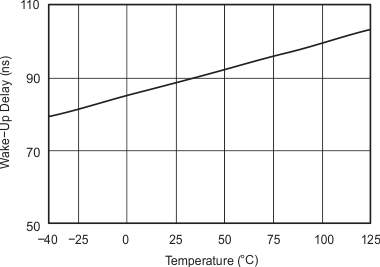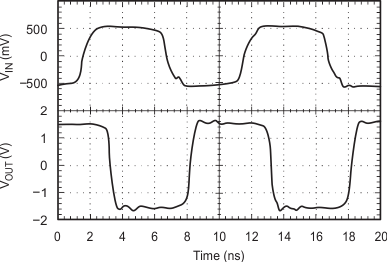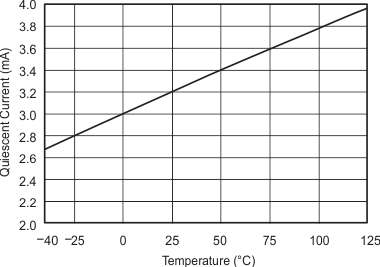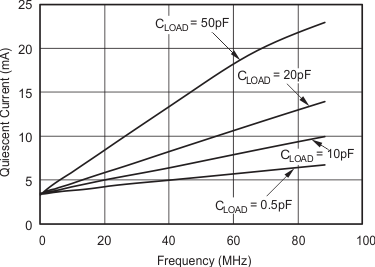SBOS321E March 2005 – April 2016 TLV3501 , TLV3502
PRODUCTION DATA.
- 1 Features
- 2 Applications
- 3 Description
- 4 Revision History
- 5 Pin Configuration and Functions
- 6 Specifications
- 7 Detailed Description
- 8 Application and Implementation
- 9 Power Supply Recommendations
- 10Layout
- 11Device and Documentation Support
- 12Mechanical, Packaging, and Orderable Information
Package Options
Mechanical Data (Package|Pins)
Thermal pad, mechanical data (Package|Pins)
- DCN|8
Orderable Information
6 Specifications
6.1 Absolute Maximum Ratings
over operating free-air temperature range (unless otherwise noted)(1)| MIN | MAX | UNIT | |||
|---|---|---|---|---|---|
| Voltage | Supply | 5.5 | V | ||
| Signal input terminal(2) | (V−) − 0.3 | (V+) + 0.3 | V | ||
| Current | Signal input terminal(2) | 10 | mA | ||
| Output short circuit(3) | 74 | mA | |||
| Temperature | Operating, TA | –40 | 125 | °C | |
| Junction, TJ | 150 | °C | |||
| Storage, Tstg | –65 | 150 | °C | ||
(1) Stresses beyond those listed under Absolute Maximum Ratings may cause permanent damage to the device. These are stress ratings only, which do not imply functional operation of the device at these or any other conditions beyond those indicated under Recommended Operating Conditions. Exposure to absolute-maximum-rated conditions for extended periods may affect device reliability.
(2) Input terminals are diode-clamped to the power-supply rails. Input signals that can swing more than 0.3 V beyond the supply rails must be current-limited to 10 mA or less.
(3) Short-circuit to ground, one comparator per package.
6.2 ESD Ratings
| VALUE | UNIT | |||
|---|---|---|---|---|
| V(ESD) | Electrostatic discharge | Human-body model (HBM), per ANSI/ESDA/JEDEC JS-001(1) | ±3000 | V |
| Charged-device model (CDM), per JEDEC specification JESD22-C101(2) | ±500 | |||
(1) JEDEC document JEP155 states that 500-V HBM allows safe manufacturing with a standard ESD control process.
(2) JEDEC document JEP157 states that 250-V CDM allows safe manufacturing with a standard ESD control process.
6.3 Recommended Operating Conditions
over operating free-air temperature range (unless otherwise noted).| MIN | NOM | MAX | UNIT | ||
|---|---|---|---|---|---|
| VS | Supply voltage | 2.2 | 2.7 | 5.5 | V |
| VIL | Low-level input voltage, SHDN (comparator is enabled)(1) | (V+) – 1.7 | V | ||
| VIH | High-level input voltage, SHDN (comparator is disabled)(1) | (V+) – 0.9 | V | ||
| TA | Operating temperature | –40 | 125 | °C | |
(1) When the SHDN pin is within 0.9 V of the most positive supply, the part is disabled. When it is more than 1.7 V below the most positive supply, the part is enabled.
6.4 Thermal Information: TLV3501
| THERMAL METRIC(1) | TLV3501 | UNIT | ||
|---|---|---|---|---|
| DBV (SOT-23) | D (SOIC) | |||
| 6 PINS | 8 PINS | |||
| RθJA | Junction-to-ambient thermal resistance | 192.2 | 129.5 | °C/W |
| RθJC(top) | Junction-to-case (top) thermal resistance | 134.8 | 75.9 | °C/W |
| RθJB | Junction-to-board thermal resistance | 37.1 | 69.8 | °C/W |
| ψJT | Junction-to-top characterization parameter | 28.3 | 29.7 | °C/W |
| ψJB | Junction-to-board characterization parameter | 36.7 | 69.3 | °C/W |
| RθJC(bot) | Junction-to-case (bottom) thermal resistance | — | — | °C/W |
6.5 Thermal Information: TLV3502
| THERMAL METRIC(1) | TLV3502 | UNIT | ||
|---|---|---|---|---|
| D (SOIC) | DCN (SOT-23) | |||
| 8 PINS | 8 PINS | |||
| RθJA | Junction-to-ambient thermal resistance | 116.4 | 191.6 | °C/W |
| RθJC(top) | Junction-to-case (top) thermal resistance | 61.7 | 43.9 | °C/W |
| RθJB | Junction-to-board thermal resistance | 57 | 120.3 | °C/W |
| ψJT | Junction-to-top characterization parameter | 18.5 | 14.4 | °C/W |
| ψJB | Junction-to-board characterization parameter | 56.5 | 118.6 | °C/W |
| RθJC(bot) | Junction-to-case (bottom) thermal resistance | — | — | °C/W |
(1) For more information about traditional and new thermal metrics, see the Semiconductor and IC Package Thermal Metrics application report, SPRA953.
6.6 Electrical Characteristics
At TA = 25°C and VS = 2.7 V to 5.5 V, unless otherwise noted.| PARAMETER | TEST CONDITIONS | MIN | TYP | MAX | UNIT | ||
|---|---|---|---|---|---|---|---|
| OFFSET VOLTAGE | |||||||
| VOS | Input offset voltage(1) | VCM = 0 V, IO = 0 mA | ±1 | ±6.5 | mV | ||
| dVOS/dT | Input offset voltage vs temperature | TA = –40°C to +125°C | ±5 | μV/°C | |||
| PSRR | Input offset voltage vs power supply | VS = 2.7 V to 5.5 V | 100 | 400 | μV/V | ||
| Input hysteresis | 6 | mV | |||||
| INPUT BIAS CURRENT | |||||||
| IB | Input bias current(2) | VCM = VCC/2 | ±2 | ±10 | pA | ||
| IOS | Input offset current(2)(3) | VCM = VCC/2 | ±2 | ±10 | pA | ||
| INPUT VOLTAGE RANGE | |||||||
| VCM | Common-mode voltage range | (V−) − 0.2 | (V+) − 0.2 | V | |||
| CMRR | Common-mode rejection ratio | VCM = −0.2 V to (V+) + 0.2 V | 57 | 70 | dB | ||
| VCM = −0.2 V to (V+) + 0.2 V, TA = −40°C to +125°C |
55 | ||||||
| INPUT IMPEDANCE | |||||||
| Common-mode | 1013 || 2 | Ω || pF | |||||
| Differential | 1013 || 4 | Ω || pF | |||||
| OUTPUT | |||||||
| VOH, VOL | Voltage output swing from rail | IOUT = ±1 mA | 30 | 50 | mV | ||
| SHUTDOWN | |||||||
| tOFF | Shutdown turnoff time | 30 | ns | ||||
| tON | Shutdown turnon time | 100 | ns | ||||
| VL | SHDN low threshold | Comparator is enabled(4) | (V+) − 1.7 | V | |||
| VH | SHDN high threshold | Comparator is disabled(4) | (V+) − 0.9 | V | |||
| Input bias current of shutdown pin | 2 | pA | |||||
| IQSD | Quiescent current in shutdown | 2 | µA | ||||
| POWER SUPPLY | |||||||
| VS | Specified voltage | 2.7 | 5.5 | V | |||
| Operating voltage range | Higher end | 2.2 | V | ||||
| Lower end | 5.5 | ||||||
| IQ | Quiescent current | VS = 5 V, VO = High | 3.2 | 5 | mA | ||
| TEMPERATURE RANGE | |||||||
| Specified range | –40 | 125 | °C | ||||
| Operating range | –40 | 125 | °C | ||||
(1) VOS is defined as the average of the positive and the negative switching thresholds.
(2) Not production tested.
(3) The difference between IB+ and IB–.
(4) When the shutdown pin is within 0.9 V of the most positive supply, the part is disabled. When it is more than 1.7 V below the most positive supply, the part is enabled.
6.7 Switching Characteristics
At TA = 25°C and VS = 2.7 V to 5.5 V, unless otherwise noted.| PARAMETER | TEST CONDITIONS | MIN | TYP | MAX | UNIT | ||
|---|---|---|---|---|---|---|---|
| T(pd) | Propagation delay time(1)(2) | ΔVIN = 100 mV, Overdrive = 20 mV |
At TA = 25°C | 4.5 | 6.4 | ns | |
| At TA = −40°C to +125°C | 7 | ns | |||||
| ΔVIN = 100 mV, Overdrive = 5 mV |
At TA = 25°C | 7.5 | 10 | ns | |||
| At TA = −40°C to +125°C | 12 | ns | |||||
| Δt(SKEW) | Propagation delay skew(3) | ΔVIN = 100 mV, overdrive = 20 mV | 0.5 | ns | |||
| fMAX | Maximum toggle frequency | Overdrive = 50 mV, VS = 5 V | 80 | MHz | |||
| tR | Rise time(4) | 1.5 | ns | ||||
| tF | Fall time(4) | 1.5 | ns | ||||
(1) Not production tested.
(2) Propagation delay cannot be accurately measured with low overdrive on automatic test equipment. This parameter is ensured by characterization and testing at 100-mV overdrive.
(3) The difference between the propagation delay going high and the propagation delay going low.
(4) Measured between 10% of VS and 90% of VS.
6.8 Typical Characteristics
At TA = 25°C, VS = 5 V, and input overdrive = 100 mV, unless otherwise noted.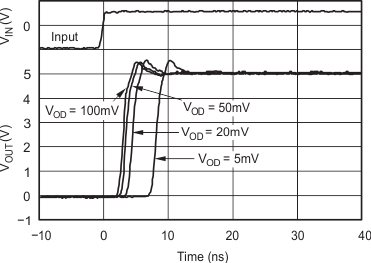
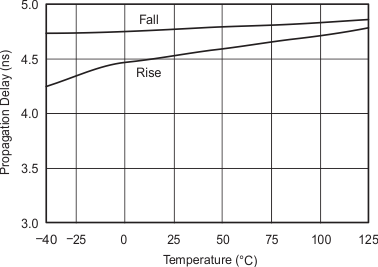
| VOD = 20 mV |
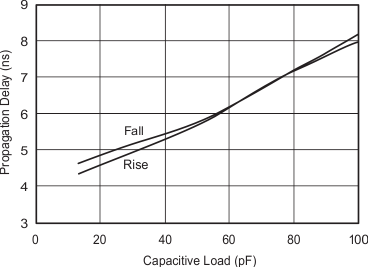
| VOD = 20 mV |
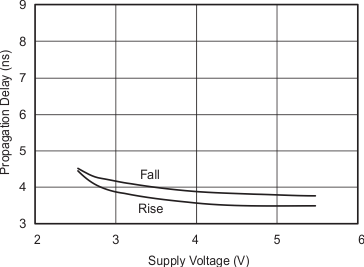
| VCM = 1 V | VOD = 20 mV |
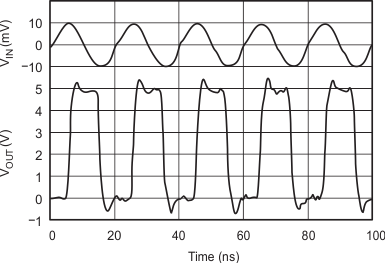
| VDD = 5 V | VIN = 20 mVPP |
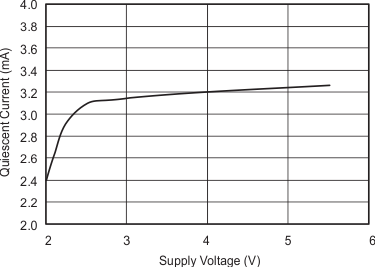
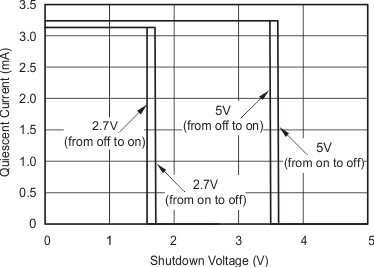
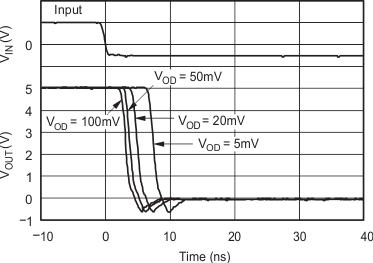
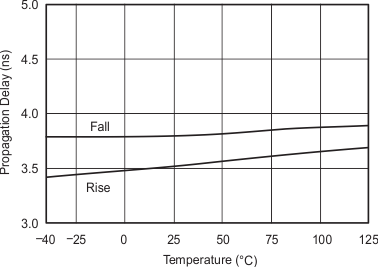
| VOD = 50 mV |
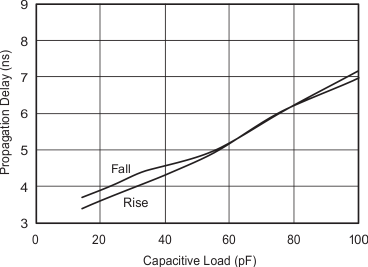
| VOD = 50 mV |
